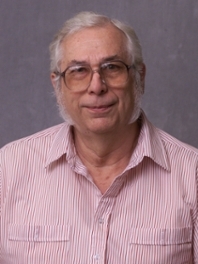Prof. Jim Douglas
05-02-2016

Jim Douglas Jr., the Compere and Marcella Loveless Distinguished Professor Emeritus of Computational Mathematics at Purdue University, died April 27, 2016, after a brief illness.
Born in Austin, Texas, in 1927, he was awarded undergraduate and masters degrees in Civil Engineering from the University of Texas in 1946 and 1947, respectively. He was awarded a Ph.D. in mathematics from Rice University in 1952.
He began his career at Humble Oil, which was later a part of the Exxon-Mobil Corporation working alongside Henry Rachford, Don Peaceman, and John Rice — now the W. Brooks Fortune Distinguished Professor Emeritus of Computer Science at Purdue University. The focus of the research was simulating numerically the flow of fluids such as oil or natural gas.
As Peaceman describes in "A Personal Retrospection of Reservoir Simulation", the computing devices they were using in 1955 had extremely limited storage, only being capable of holding 864 words. Their machine did not have enough storage to use the usual method of Gaussian elimination. In response, Douglas, Peaceman, and Rachford developed the so-called Alternating-Direction Implicit (ADI) method for solving finite-difference approximations to parabolic partial differential equations.
The linear equations they needed to solve approximated the sum of second derivatives in two directions, say x and y. On an NxN grid there were N2 unknowns and using Gaussian elimination to approximate the solution required about N3 intermediate storage locations. For N of any size at all, their machine did not have enough storage to use the usual method of Gaussian elimination.
With ADI the idea was to alternately solve auxiliary one-dimensional problems in x and y separately; each auxiliary problem required only about N words of intermediate storage, and that storage could be reused. The ADI method received a lot of attention. Later it was realized that this basic technique could be applied to the sum of even nonlinear, nonsmooth operators of the right form (so-called monotone operators).
The Douglas-Rachford variant of the method became an important technique in convex analysis, monotone operators, and most recently in areas of "Big Data". Indeed, Scopus reports that in 2015 alone 230 entries in its citation database contain the term "Douglas-Rachford", of which 128 are in Computer Science and 25 are in Decision Sciences.
In 1957 he was appointed Assistant Professor of Mathematics at Rice University; and was promoted to Full Professor in 1961 and named the W.L. Moody Professor in 1964.
A highlight of his early career was participating in the first large US-USSR mathematics meeting. Richard Courant chose Prof. Douglas as one of 23 American mathematicians in a meeting in Novosibirsk, USSR, on partial differential equations in August 1963. This meeting was organized under the auspices of the US National Academy of Sciences and the Academy of Sciences of the USSR.
Prof. Douglas moved to the University of Chicago in 1967. It was at that time that he played a large role in developing the mathematical understanding of the finite element method for partial differential equations; a good deal of this work was with Todd Dupont, who was first Jim's student at Rice and then a colleague at Chicago.
In 1987, he was appointed Director of the Center for Applied Mathematics and named the Compere and Marcella Loveless Distinguished Professor of Computational Mathematics at Purdue. He held these positions until his retirement in 2003.
Prof. Douglas wrote over 200 papers with over 70 co-authors. Among his many recognitions were the Cedric K. Ferguson Medal from the Society of Petroleum Engineers (1958), the Robert Earll McConnell Award from the American Institute of Mining, Metallurgical, and Petroleum Engineers (1979), and a Commemorative Medal from Charles University, Prague (1992). Jim was a Fellow of SIAM and in the inaugural class of Fellows of the American Mathematical Society.
He had a tremendous influence on young people, both as an advisor to graduate students and as someone who helped shape many professional mathematicians early in their career. One can count among his students and post-doctoral associates many Fellows of the AMS and SIAM and leaders in computational science both in the US and abroad.
Prof. Douglas is survived by his wife Graça and by his sons with his late wife Mary Lou, Jimmy and Craig.